Are you captivated by the classic charm and pure elegance of milk glass vase? Whether you’re a seasoned collector or newly intrigued by their timeless allure, understanding the rich history, diverse styles, and practical uses of these iconic pieces is essential. This article is your definitive guide to the enchanting world of milk glass vase, from their origins in 16th-century Venice to tips on styling them in your modern home.
Key Takeaways
Milk glass vases, with origins in 16th century Venice, evolved beyond their opaque white appearance to include a range of colors and opacities, becoming timeless home decor pieces valued by collectors.
Brands like Fenton Art Glass Company, Westmoreland Glass Company, and Anchor Hocking Glass Corporation are notable for their quality milk glass vases, with patterns like Hobnail and Silvercrest being particularly collectible.
The value of milk glass vases is determined by factors such as age, manufacturer, rarity, and condition, with older and well-preserved pieces from recognizable brands generally commanding higher prices.
The Beauty of Milk Glass Vases

Milk glass vases possess a subtle beauty and enduring sophistication that make them an essential addition to any decor. The pristine white hue of milk glass provides unparalleled adaptability, seamlessly integrating with diverse home design schemes. Due to their perennial charm and detailed craftsmanship, these pieces are a consistent favorite for enhancing environments in both modern and traditional settings.
Originating from the 16th century, milk glass has sustained its appeal through centuries, garnering admiration from collectors and connoisseurs of fine decor.
History of Milk Glass
Initially crafted by Venetian artisans in the 1500s, milk glass, or opal glass as it is alternatively known, gained its unique opaque quality from additives like bone ash, arsenic, or tin oxide. It was during the Victorian era that this type of glass earned the moniker ‘milk glass,’ due to its resemblance to highly valued porcelain at the time.
The production of milk glass on a large scale began with American manufacturers in the 1800s, which catapulted its popularity substantially. The height of its demand spanned from late in that century into the early parts of the following century. Its milky and lustrous finish also inspired Victorians to refer to it as ‘opal glass.’’
Types of Milk Glass
Milk glass is traditionally recognized by its signature opaque white hue. It has expanded its palette to encompass a multitude of colors including blue, pink, yellow, brown, and black. This expansion enhances milk glass’s attractiveness.
The level of opacity in milk glass can differ significantly. Some pieces may be fully opaque for a richer white visual impact while others might display semi-translucency that achieves the appearance similar to frosted glass.
With this variety in coloration and transparency options, milk glass vases are versatile enough to integrate seamlessly with numerous design aesthetics and various color palettes used in interior decorating.
Popular Milk Glass Patterns
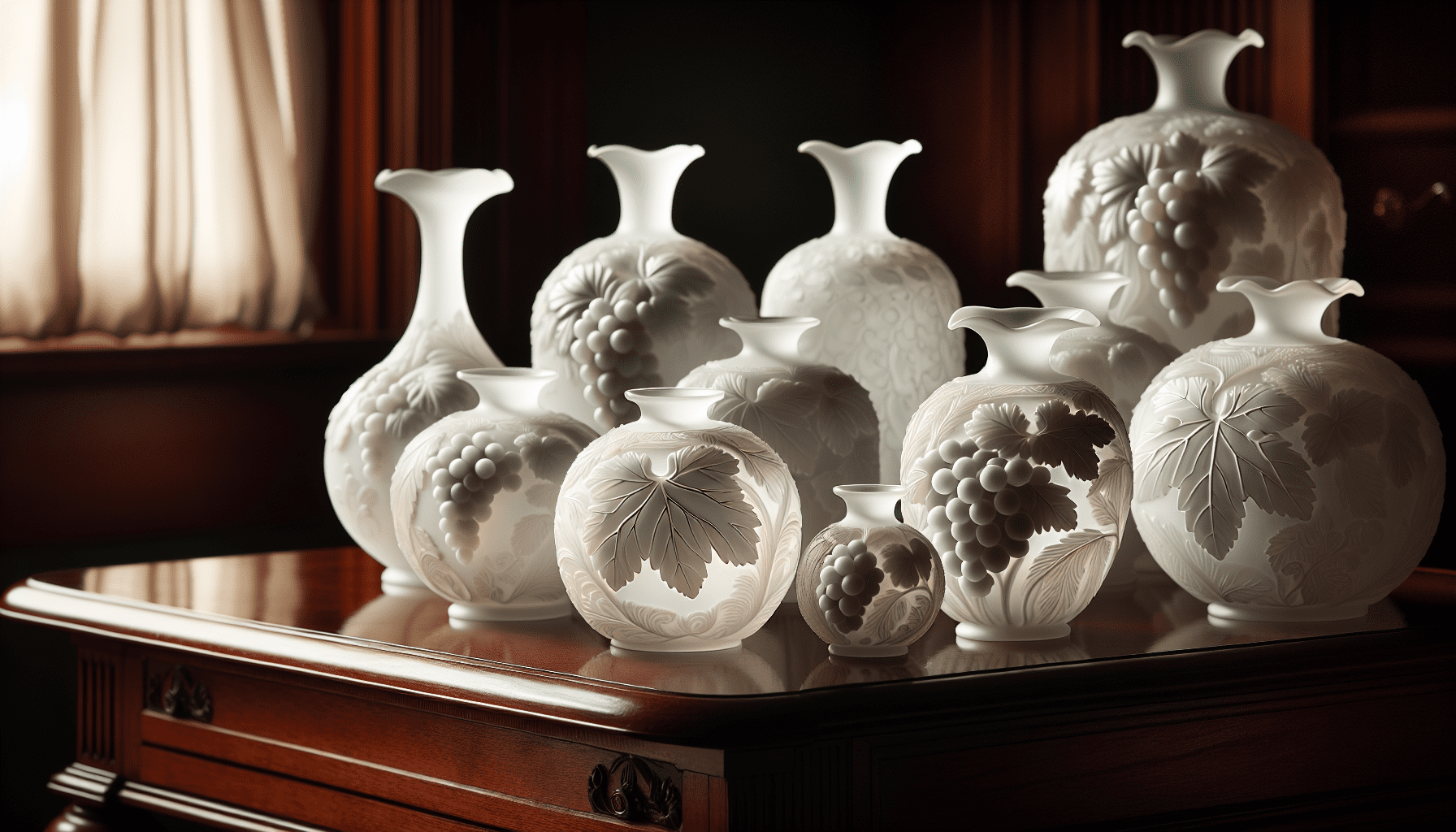
Renowned for their elaborate designs, milk glass vases often boast embossed or molded floral patterns, with each vase presenting distinct variations in design and texture. Grape leaf and oak leaf patterns stand out as particularly prominent motifs within this category and are produced by a variety of manufacturers.
Collectors highly value these unique and historically significant milk glass pieces because they were created using technologies similar to one another.
Top Milk Glass Vase Brands to Look For
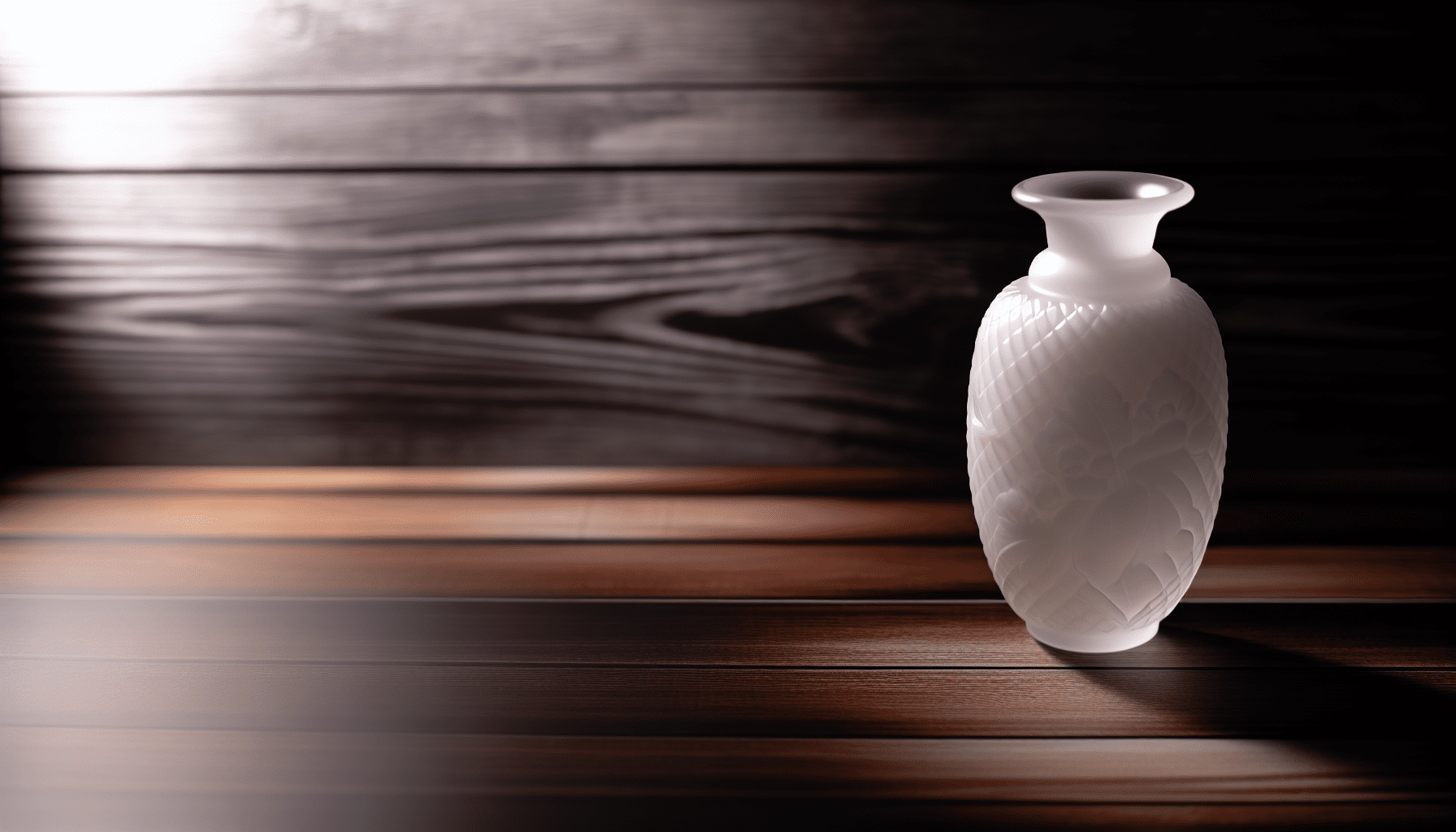
In the realm of vintage collectibles, milk glass vases hold a special place, with specific brands establishing themselves as key players. Notable among these are the Westmoreland Glass Company, Fenton Art Glass Company, and Anchor Hocking Glass Corporation, all revered for their longstanding heritage and the superior quality of their milk glass creations.
Fenton Art Glass Company
Since its establishment in 1905, the Fenton Art Glass Company has earned a reputation as a key player in glassware manufacturing, renowned for their unique milk glass vases. This company was instrumental in rejuvenating the production of milk glass during what is often referred to as its ‘golden age,’ spanning from roughly 1940 until 1970.
Collectors hold particular esteem for Fenton’s ‘Hobnail’ pattern – notable for its pointed hobnails and evocative charm – and their ‘Silvercrest’ design that elegantly merges milk glass with an accent of clear glass trim. These designs stand out among enthusiasts’ collections.
Westmoreland Glass Company
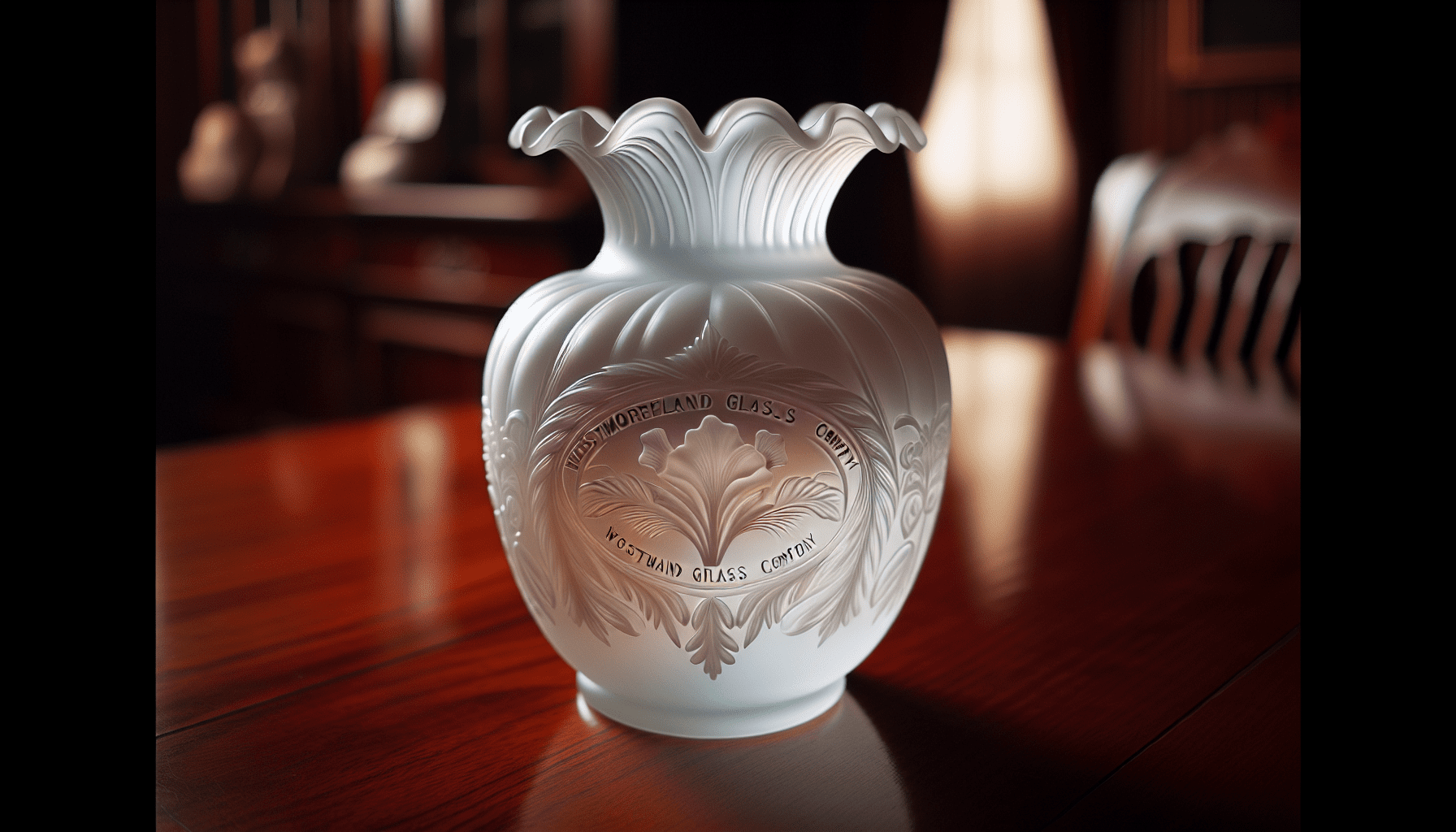
Westmoreland Glass Company has distinguished itself through the exceptional smoothness and sheen of its milk glass creations, which have become a standard that differentiates it from other manufacturers. The company’s reputation is particularly tied to their milk glass vases known for elaborate patterns. These vases are commonly adorned with sophisticated lace edges and raised designs.
Even though the Westmoreland Glass Company ceased production in 1985 when their factory shut down, their milk glass pieces remain esteemed collector’s items, enjoying continued acclaim and demand amongst enthusiasts.
Anchor Hocking Glass Corporation
Though not as widespread as Fenton and Westmoreland’s offerings, the milk glass vases produced by Anchor Hocking Glass Corporation maintain an important presence within the milk glass sector. Their longstanding tradition of crafting these pieces since the early 1900s speaks to their dedication to excellence in both quality and design.
Classic Milk Glass Vase Designs for Your Collection
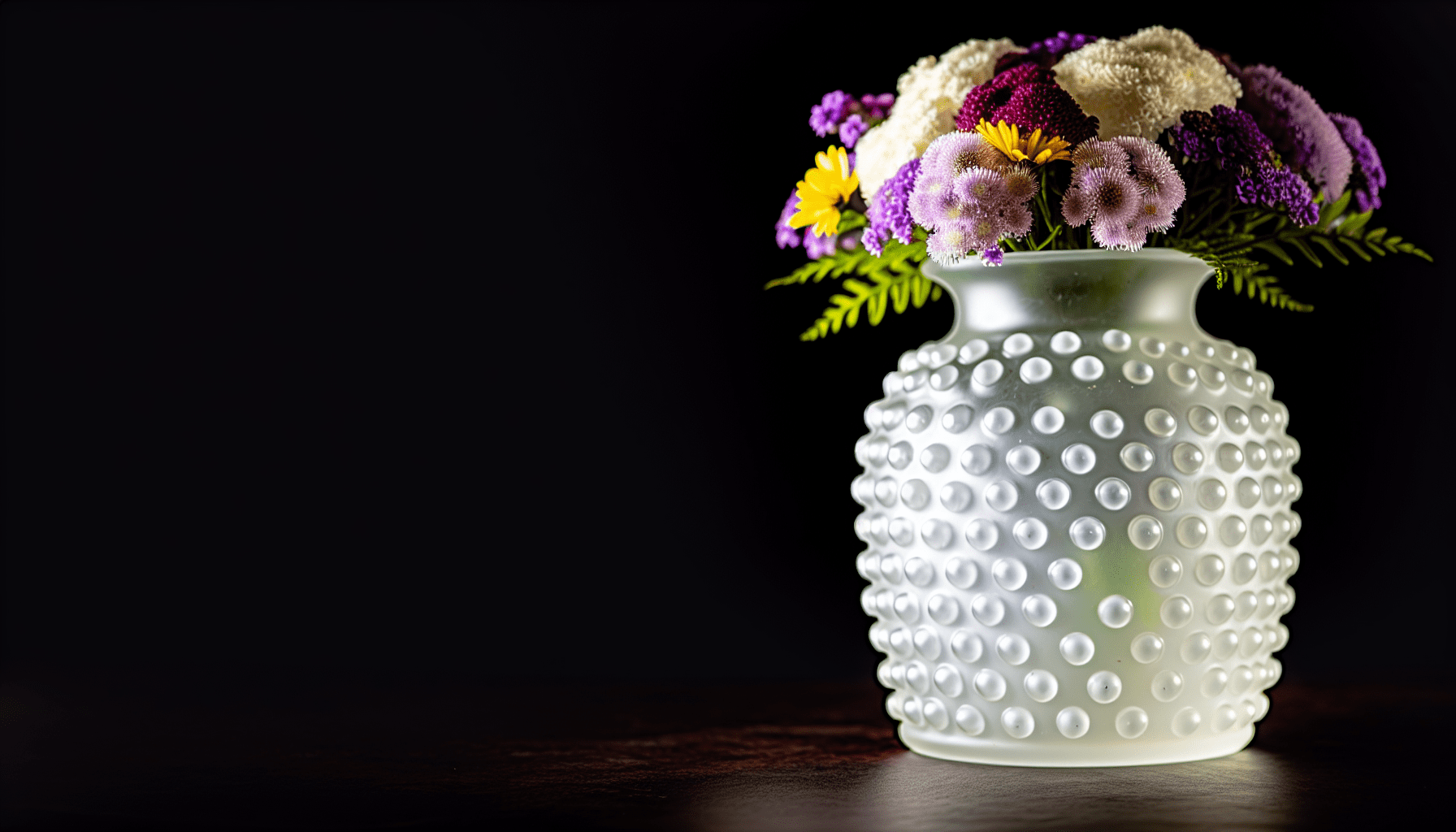
For those who appreciate vintage home decor or collectibles, understanding the timeless designs of classic milk glass vases can deepen one’s admiration for these cherished relics. The hobnail, diamond cut, and floral motifs are three patterns that have perpetuated the legacy of milk glass through their distinct visual charm, solidifying their status as enduring favorites among milk glass enthusiasts.
Hobnail Milk Glass Vases
Milk glass vases, specifically those with a hobnail design characterized by their raised bumps or knobs on the surface, are appreciated for both their tactile and aesthetic qualities. These pieces of decor bring versatility to home styling and can be used as charming decorative elements in different spaces like kitchens, bathrooms, or as part of a living room setting.
Although the Fenton Art Glass Company is renowned for crafting hobnail milk glass items, various other manufacturers have adopted this approach too. This has led to an increase in its popularity within collector circles.
Diamond Cut Milk Glass Vases
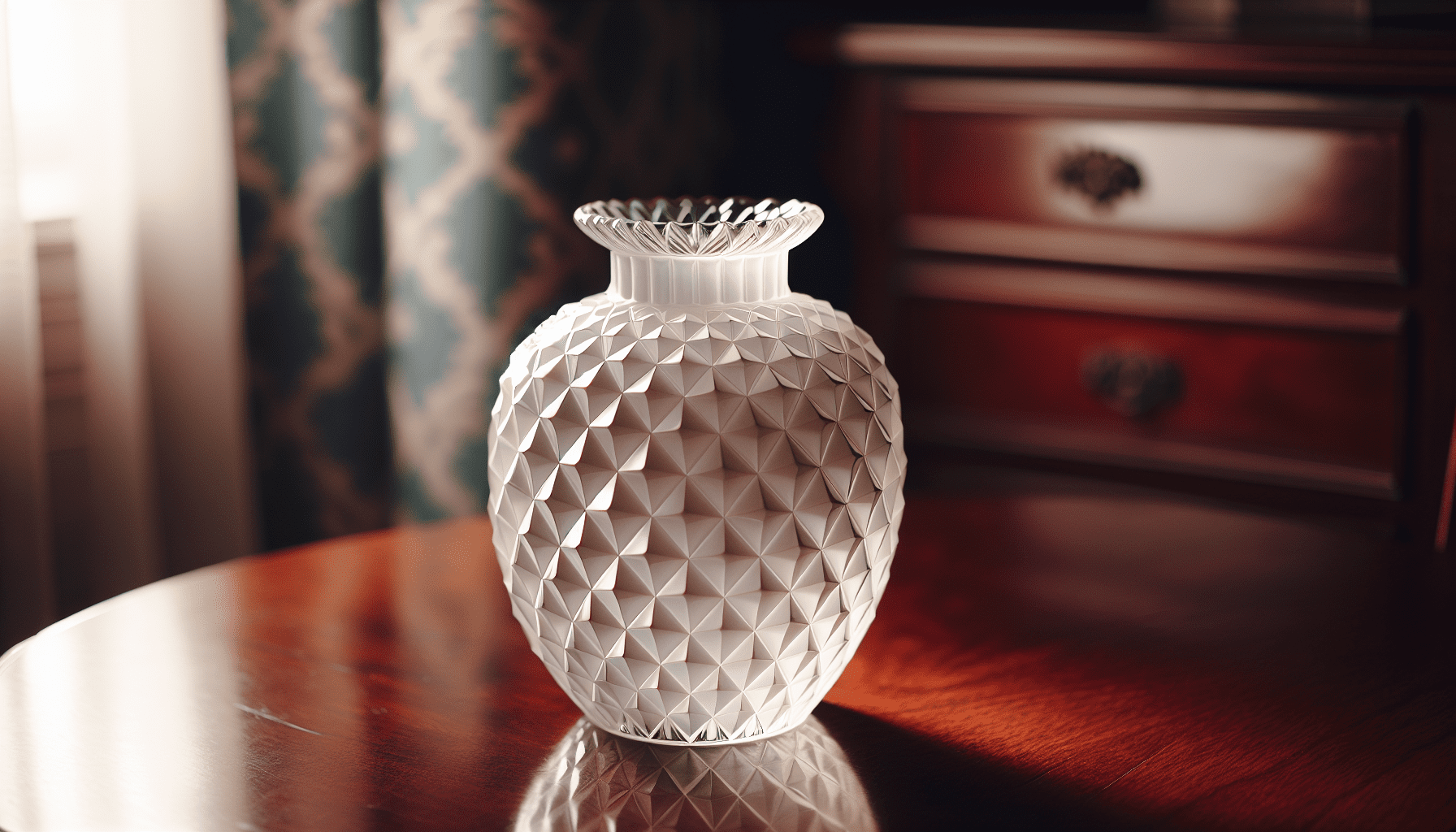
Milk glass vases with a diamond cut are a classic feature in the realm of milk glass, exhibiting a geometric design that resembles the multi-faceted surface typical of diamonds. This lends an air of elegance and refinement to them, making these vases capable of elevating the aesthetic appeal of any home’s interior decoration.
Floral Pattern Milk Glass Vases
The milk glass vase adorned with a floral pattern is a sought-after item. Its surface is decorated with raised patterns of blooms and leaves that range from understated to elaborate, offering a romantic, vintage charm. The milky white hue serves as an ideal canvas for the vibrant colors of any floral arrangement, amplifying the beauty of the bouquet it holds.
When aiming for a quaint and country-style ambiance in your decor, consider arranging odd-numbered clusters of milk glass items—for example, sets of three—which can produce an attractive display perfect for seasonal settings such as Easter celebrations.
How to Style Milk Glass Vases in Your Home
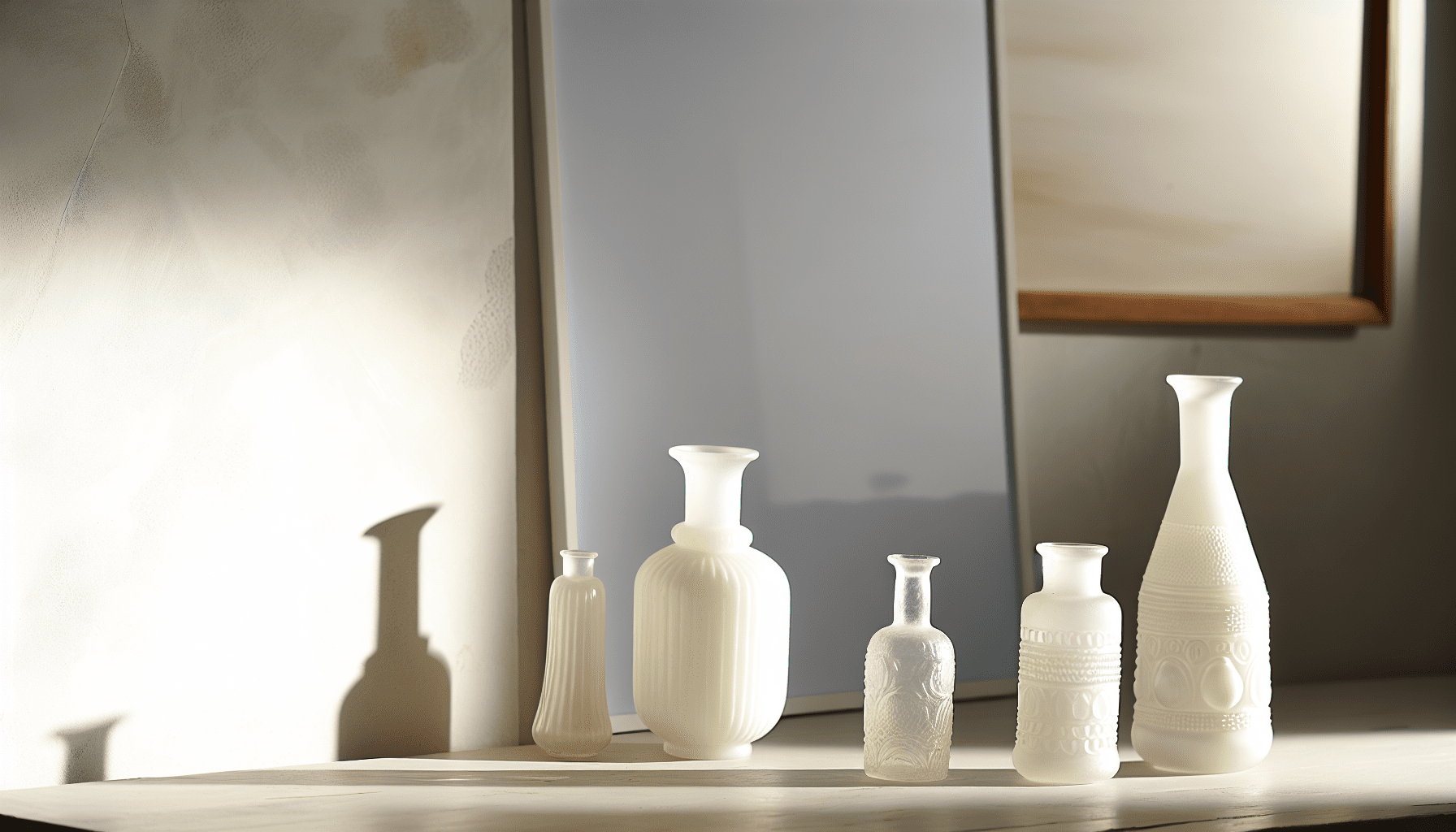
The versatility of milk glass vases is what makes them so remarkable. They seamlessly fit into modern minimalist styles as singular decorative objects, serve beautifully in vintage farmhouse settings with fresh flowers, moss, or greenery inside them, and can be assembled collectively to create harmonious arrangements.
It’s important to bear in mind that one should avoid using these milk glass vessels for extended storage of any liquids. This precaution helps in preventing stains and preserving the integrity of the glass.
Living Room Décor Ideas
Milk glass vases can add a touch of sophistication when displayed in living spaces, whether perched atop end tables, nestled among books on shelves, or gracing window sills. The allure of milk glass is particularly heightened when light filters through the vase on a sill, casting attention to its detailed designs and improving the room’s visual appeal.
Consider assembling an attractive display for spring by arranging a mix of greenery and white blooms within milk glass vases on your mantelpiece. This will not only elevate the charm of your site, but also bring forth a fresh seasonal vibe.
Dining Table Centerpieces
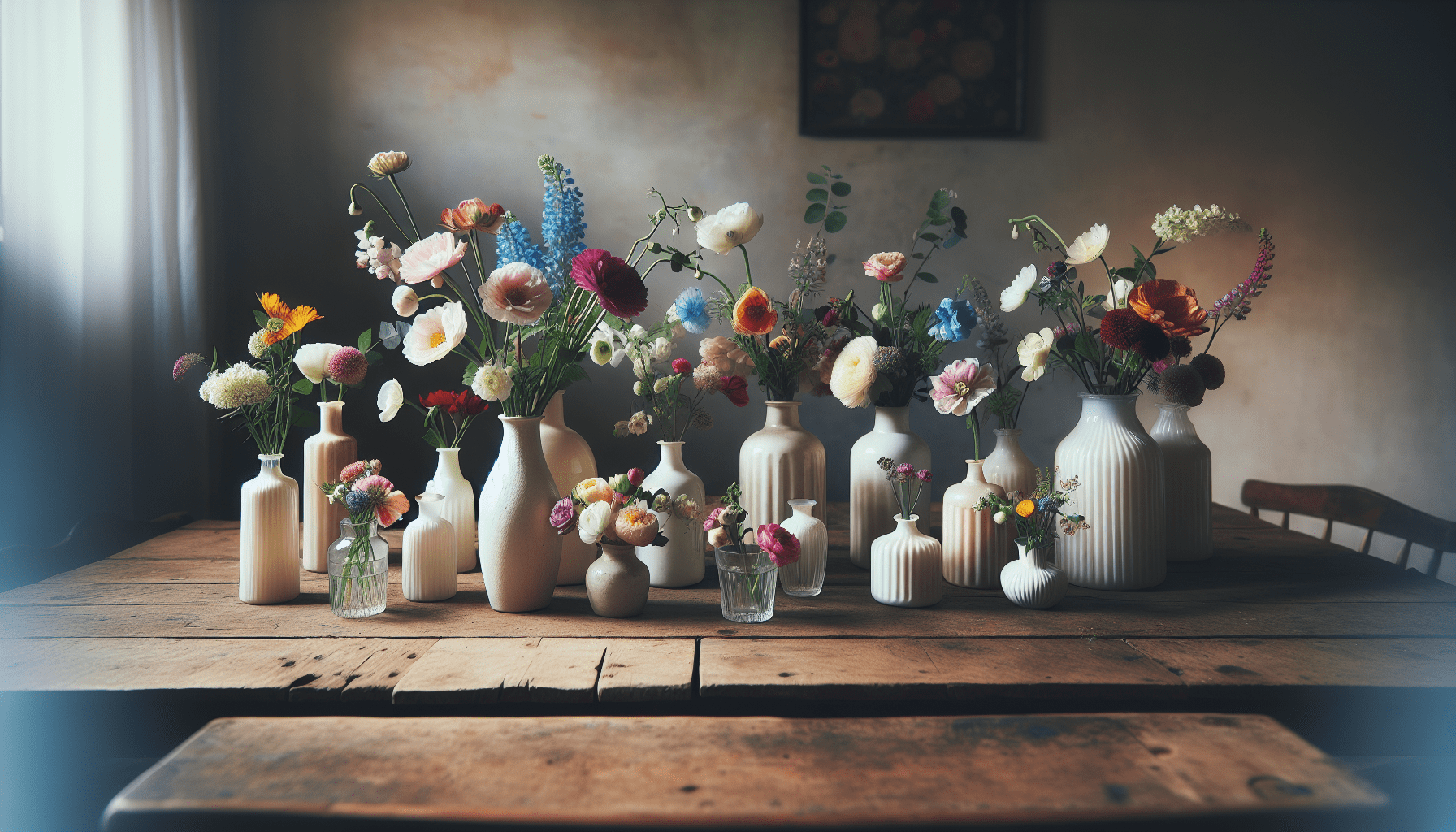
Milk glass vases are ideal for elevating the visual appeal of dining table centerpieces, with their unique capability to complement any hue of flowers and double as quaint candleholders that help produce a cozy atmosphere. To infuse an element of historic charm into your dining space, consider positioning milk glass vases alongside old-fashioned books or draping them with lace runners to reinforce their vintage allure.
For those aiming to craft symmetrical arrangements on the dining table, opt for milk glass vases sharing comparable shapes. This deliberate pairing magnifies their decorative impact when they are showcased in unity.
Bedroom Accents
Milk glass vases in bedrooms offer a combination of aesthetic charm and practical use, providing a spot for jewelry placement adjacent to picture frames or timepieces while also serving as ornamental pieces. Positioning a milk glass vase filled with blooming flowers on your nightstand or chest brings both serenity and a splash of color into the sleeping quarters.
Utilizing milk glass containers for bright greenery can elevate the room’s ambiance by infusing it with lively hues and vitality.
Caring for Your Milk Glass Vase Collection
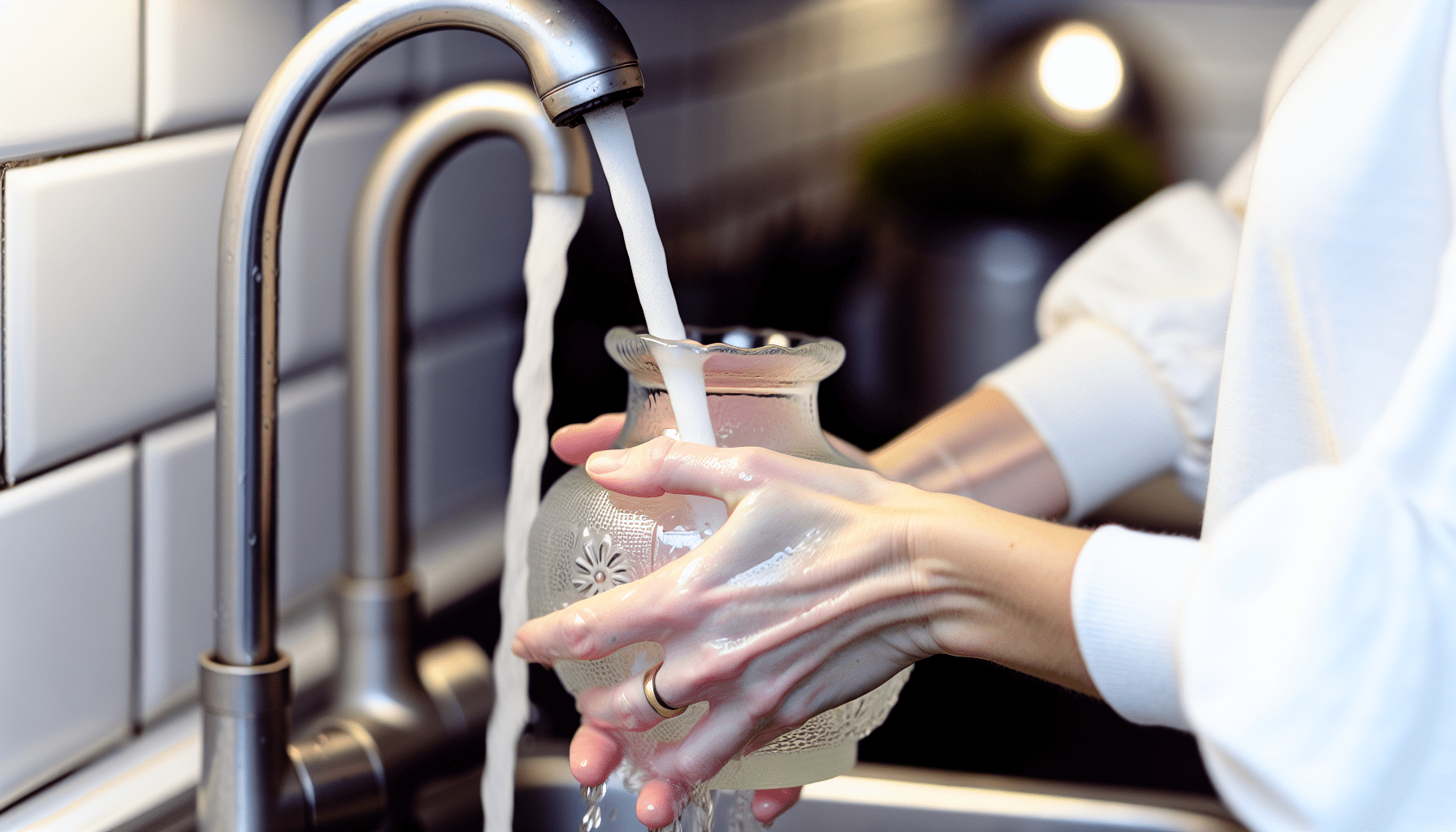
In order to preserve the gleaming look and avoid harm to your milk glass vases, proper maintenance is essential. This involves:
Softly wiping them using a delicate cloth paired with gentle soap
Consistently dusting them with a microfiber cloth
Storing each piece separately in soft packing materials such as bubble wrap or tissue paper.
It’s recommended to periodically reposition your milk glass collection so that they receive uniform exposure to environmental factors, which aids in preventing uneven coloring. It’s important to regularly check for any indications of damage like chips, cracks or wear and tear since these defects can affect both their beauty and worth.
Cleaning Tips
When maintaining your milk glass vases, it is advisable to:
Carefully hand wash these items using a soft cloth and a gentle detergent.
Immerse them in warm water mixed with vinegar for persistent stains.
Employ a toothbrush to scrub intricate spots meticulously.
Opt for a mixture of isopropyl alcohol and water as an efficient cleaning solution that preserves the integrity of the finish.
Steer clear of utilizing bleach which could lead to discoloration, and opt for distilled water over tap water when rinsing in order to avoid accumulation of mineral residues on your milk glass pieces.
Storage Solutions
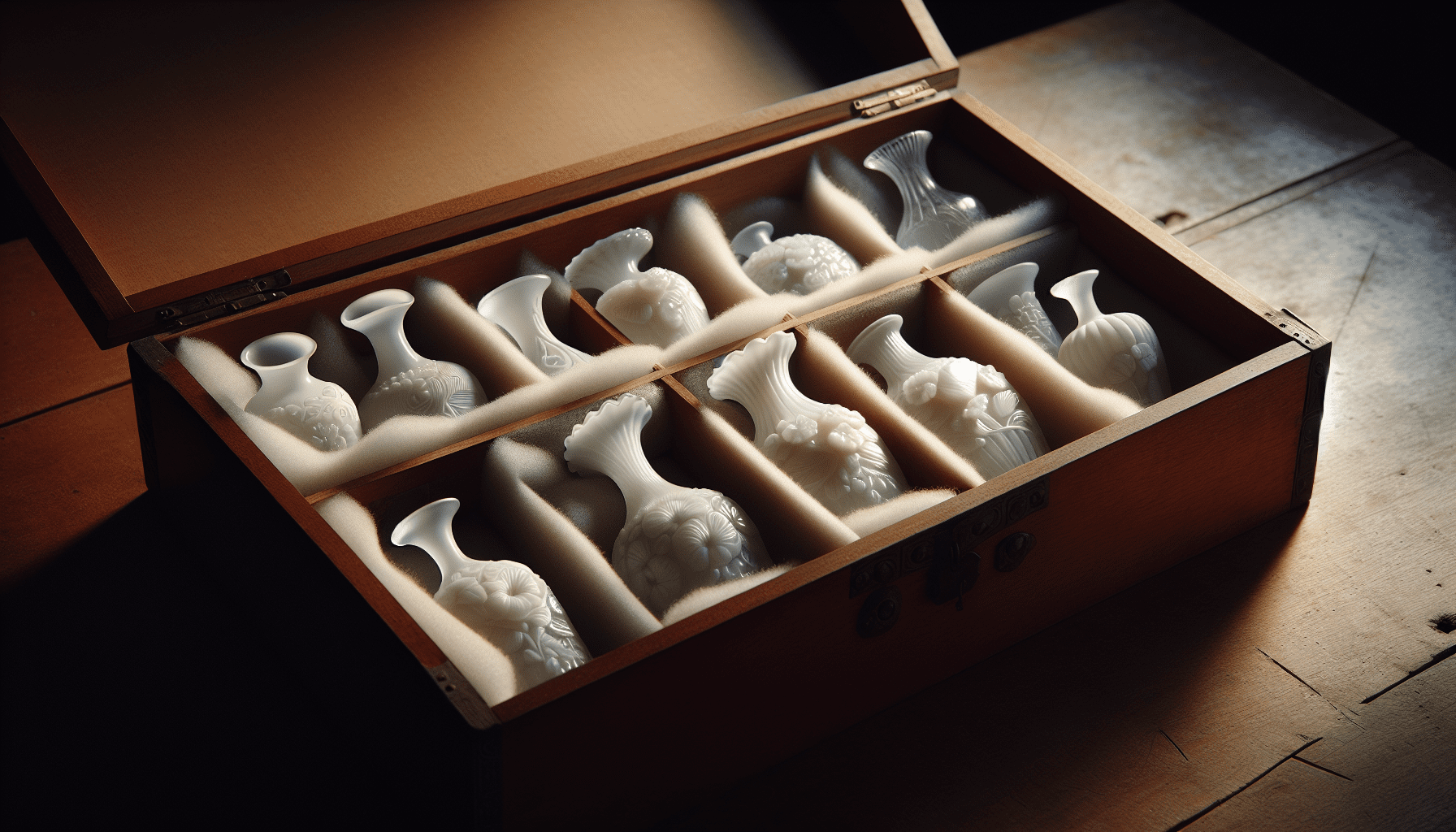
To ensure that your milk glass vases remain in pristine condition, it’s best to place them in an environment that is both cool and devoid of moisture, well away from the harmful effects of sunlight. For optimal protection during storage, make use of boxes with individual compartments padded for added cushioning which will maintain each vase separate and safeguarded. It’s advisable not to stack the milk glass vases within one another as this could lead to scratches or potential breakage. Wrapping the pieces in acid-free archival tissue paper can be beneficial when you need to store them over extended periods because it guards against harmful chemical reactions harming the milk glass.
Remember too that labeling your containers clearly with details about what they contain along with any special handling directives is crucial for maintaining security and ensuring proper care throughout transportation or while reshuffling storage spaces — a step equally important when managing sensitive data.
Display Ideas
Exhibiting your collection of milk glass vases can be as delightful as gathering them. Consider these suggestions for presenting your pieces:
Position the vases close to sources of light, like windows or lamps, to emphasize their unique texture and project beautiful shadows onto adjacent areas.
Apply white paint on the inside surface of clear shelving to produce a unified backdrop that accentuates your milk glass vase display.
Install shelves or shadow boxes at a level where they catch the eye easily, making the vases stand out in your home’s aesthetic.
Creating an ensemble of milk glass vases with varying shapes and sizes on ledges or mantelpieces can draw attention effectively, while thoughtfully interspersing them among books on a bookshelf offers both balance and visual appeal. Showcasing these treasures within a china cabinet or curio not only safeguards against dust and potential damage, but also provides an orderly exhibition framework for admiration.
Where to Buy Authentic Milk Glass Vases

Enthusiasts and collectors in search of genuine milk glass vases should be aware of the several reputable outlets where they can acquire these items. Antique stores are frequently a treasure trove for vintage finds, such as authentic milk glass vases. It’s crucial to remain knowledgeable and vigilant so as not to fall prey to counterfeit or reproduction pieces masquerading as originals.
Online Marketplaces
Marketplaces on the internet provide a vast selection of milk glass vases to suit various tastes and collector demands. Websites such as eBay and Etsy are particularly renowned for their assortment of milk glass pieces. These online platforms are ideal destinations for consumers looking to purchase distinctive, specialty items, encompassing both vintage and colored milk glass vases.
Antique Stores
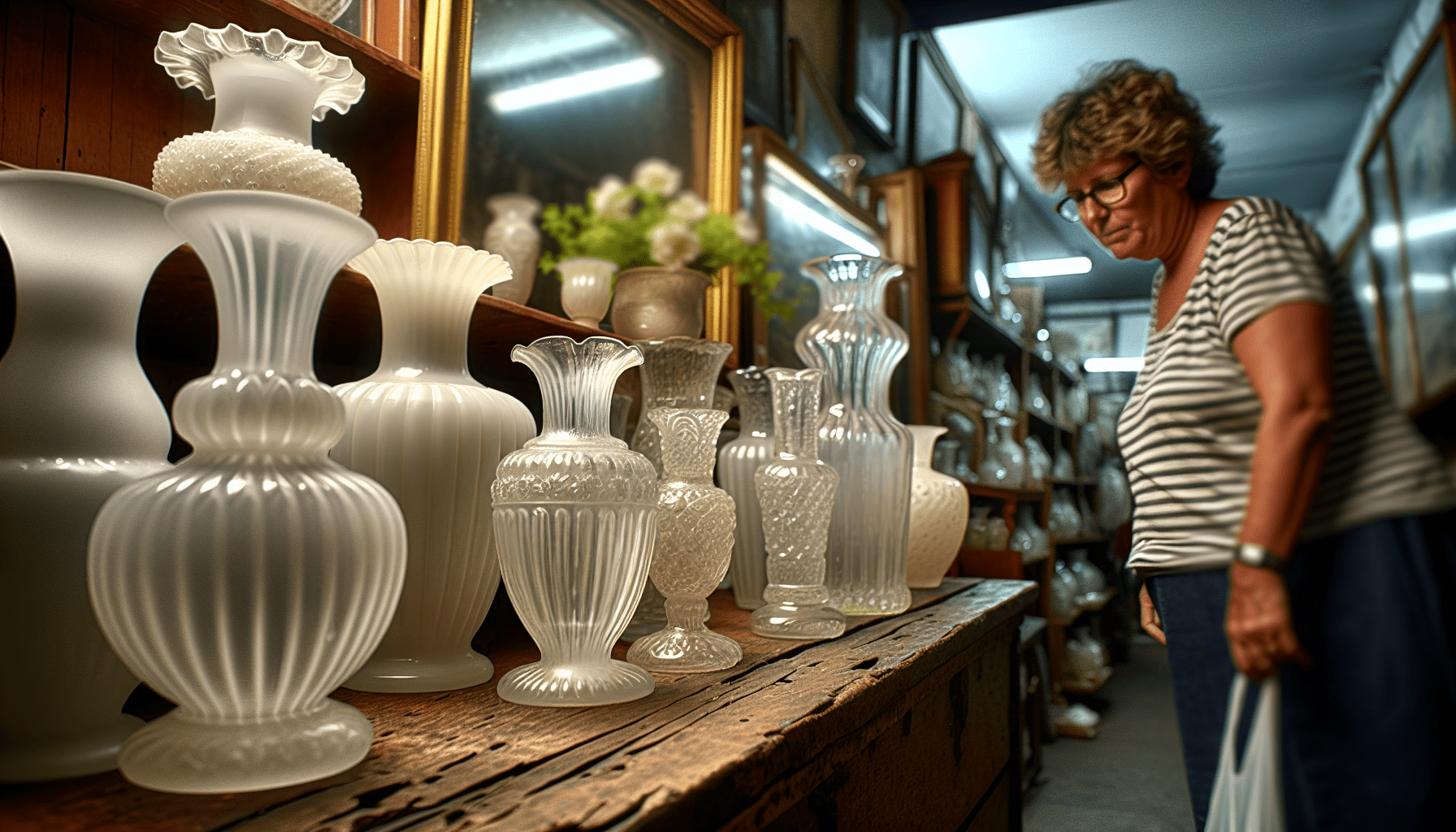
Collectors frequently flock to antique shops in pursuit of milk glass vases, which are commonly found as items crafted during the 1950s—a time when the popularity of milk glass was at its zenith.
Auctions and Estate Sales
For those just beginning their collection of milk glass vases and similar pieces, auctions and estate sales present profitable avenues. Notable auction houses and digital forums for consideration are:
Apple Tree Auction Center
Nest Egg Auctions
Invaluable
LiveAuctioneers
Collectors have access to an extensive assortment of milk glass vases advertised in the stock listings on these platforms.
Estate sales offer a golden chance for aficionados to acquire distinctive milk glass vases that often originate from private collections undergoing liquidation.
The Value of Milk Glass Vases
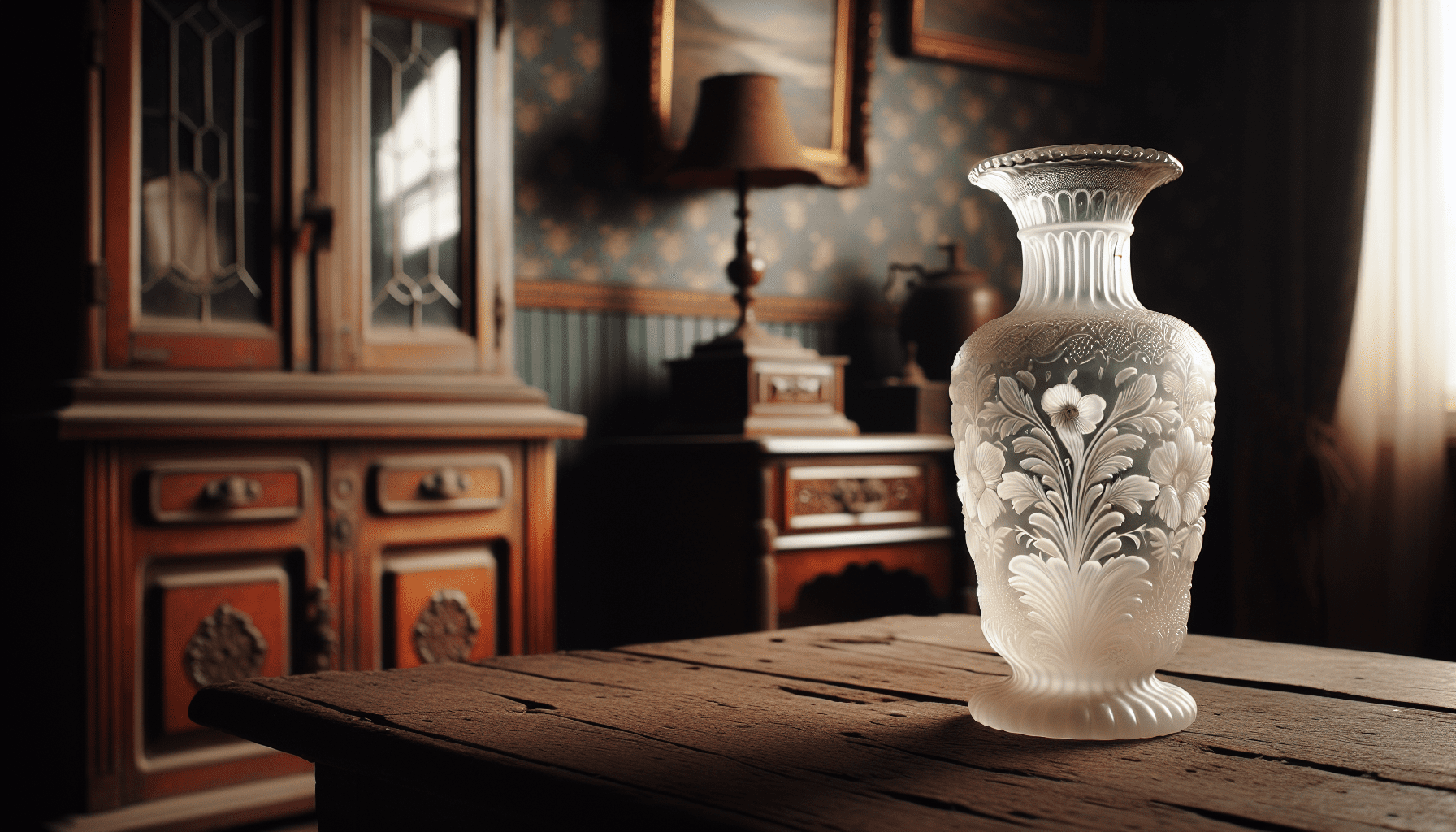
The cost of milk glass vases is influenced by several key elements, such as:
The period in which they were produced
The maker of the vase
Their scarcity
Overall state or preservation
Pieces originating from respected makers like Fenton Art Glass Company Attract collectors and may possess considerable value.
Specifically, ‘Art glass’ selections that include adorned milk glass articles crafted by Fenton are recognized for fetching a higher selling price.
Determining Age
Assessing the value of milk glass vases can be aided by identifying their age, since vintage pieces typically carry higher value. If a vase is stamped with a patent number, it often signifies that it was part of the initial batch produced under that particular design’s patent, indicating an older origin and possibly greater value.
Identifying Manufacturers
It is essential to discern manufacturer markings and distinctive patterns for the authentication and valuation of milk glass vases. Identifying specific marks, such as Westmoreland’s keystone with the ‘W’ or Fenton’s oval imprint, aids in pinpointing the producer. Classic designs like Westmoreland’s ‘Paneled Grape’ and ‘Shell and Jewel’ are also indicative of their origins.
This knowledge plays a significant role for collectors or buyers interested in genuine milk glass pieces, providing assistance in analyzing their authenticity.
Assessing Rarity and Condition
The scarcity and state of preservation greatly impact the value and appeal of milk glass vases to collectors. Vases produced in shorter runs or smaller quantities, such as LE Smith’s ‘tube sock’ design, carry more rarity which can translate into greater value. Age is another factor that adds to the uniqueness of these pieces. Older examples are frequently part of private collections rather than being up for sale on common markets.
Identifying marks like mold lines or ‘seams’ can be tell-tale signs pointing to an antique status for a glass vase—particularly those crafted between the mid-19th century and early 20th century—which often boosts its value. Milk glass items that maintain pristine condition free from chips, cracks, or crazing typically command higher prices compared to their damaged counterparts.
Summary
In this journey through the world of milk glass vases, we have explored their timeless elegance, rich history, and the various brands that have contributed to their popularity. Whether you’re a seasoned collector or a novice, understanding the different designs, knowing how to care for these vases, and being aware of where to purchase authentic pieces can greatly enhance your appreciation of these vintage treasures. As we conclude, remember that each milk glass vase you collect or decorate your home with carries a piece of history, a testament to craftsmanship, and a touch of timeless elegance.
Frequently Asked Questions
Are milk glass vases worth anything?
Indeed, the value of milk glass vases can span from $15 for petite bud versions to several hundred dollars for expansive punchbowl sets, with variations influenced by their dimensions, state of preservation, and ornamental designs.
How do you tell if milk glass is real?
To determine the authenticity of milk glass, inspect it for an opaque look and a texture that feels silky to the touch. Examine any numbers or the name of a company imprinted on its bottom. These markings can assist in ascertaining both its age and genuineness.
What do you put in a milk glass vase?
Incorporating a milk glass vase filled with flowers and foliage aligned with your party motif can enhance your home’s ambiance, adding an elegant touch to the decor.
Is milk glass still being made?
Indeed, glass manufacturers continue to create milk glass, maintaining its appeal among those who collect it.
Both brand new designs and replicas of beloved vintage pieces and motifs are being crafted by these glass producers.
What is milk glass?
Venetian glass makers in the 16th century crafted an opaque variety of glass recognized for its characteristic white hue, commonly known as milk glass.

